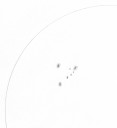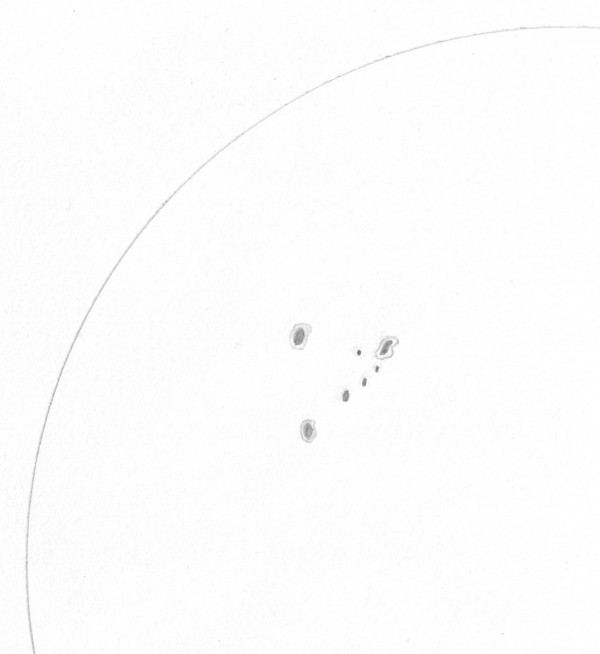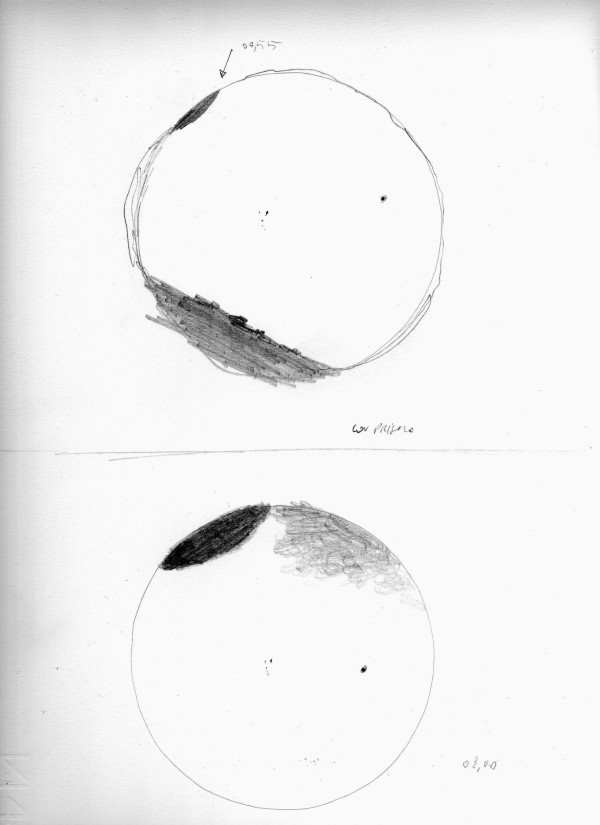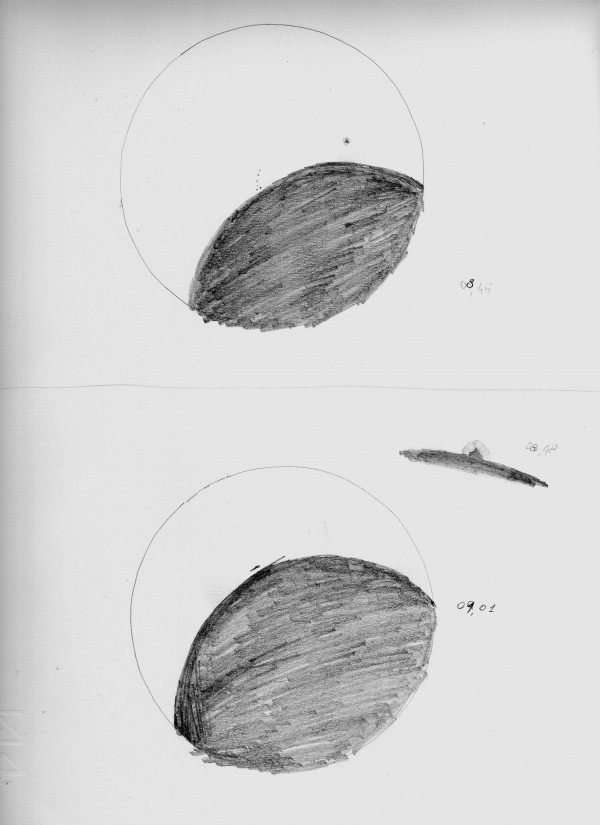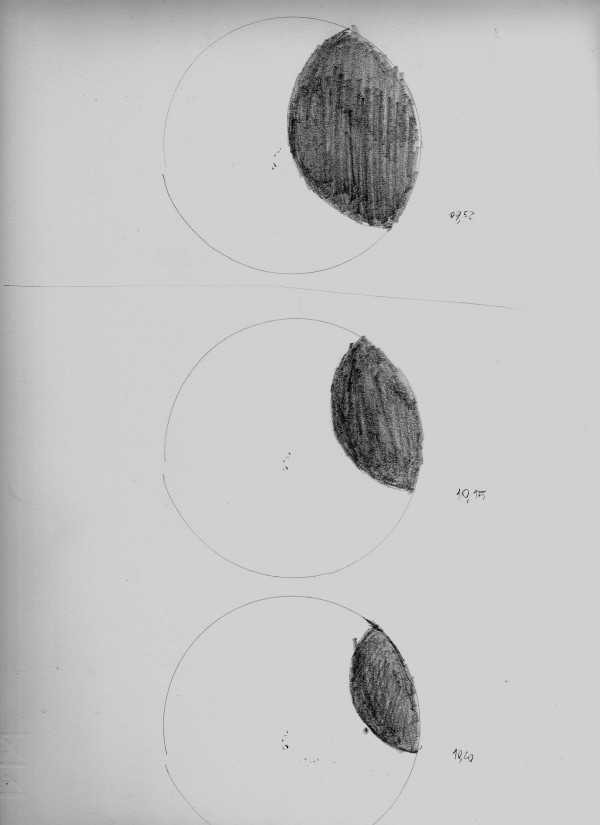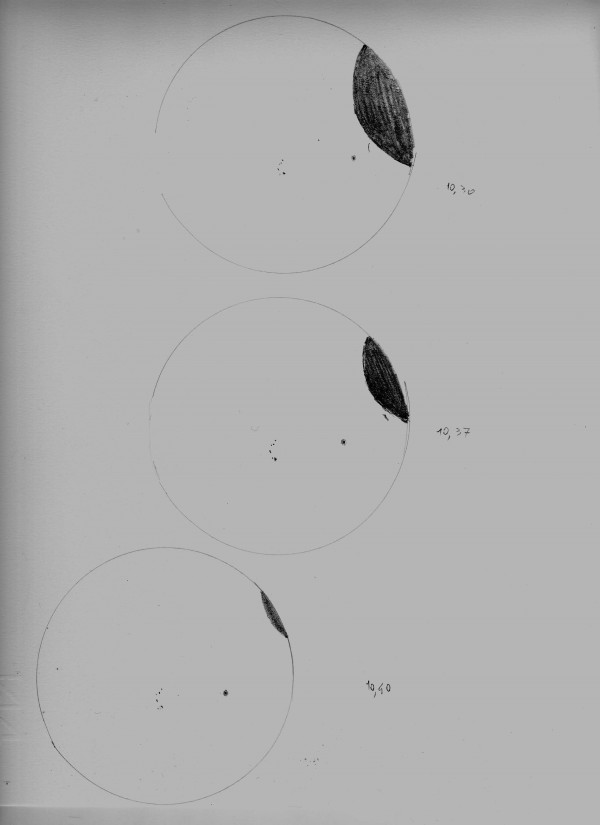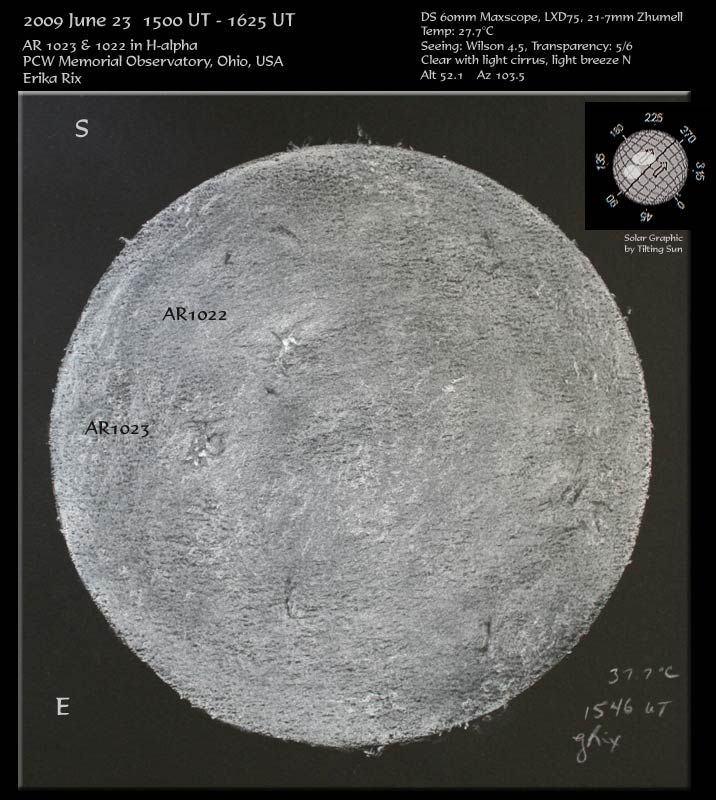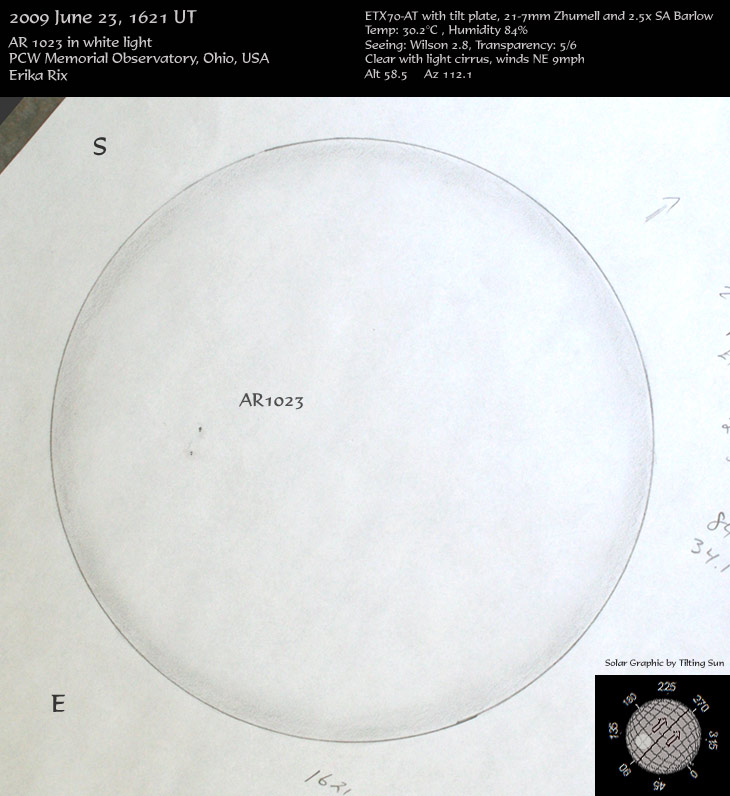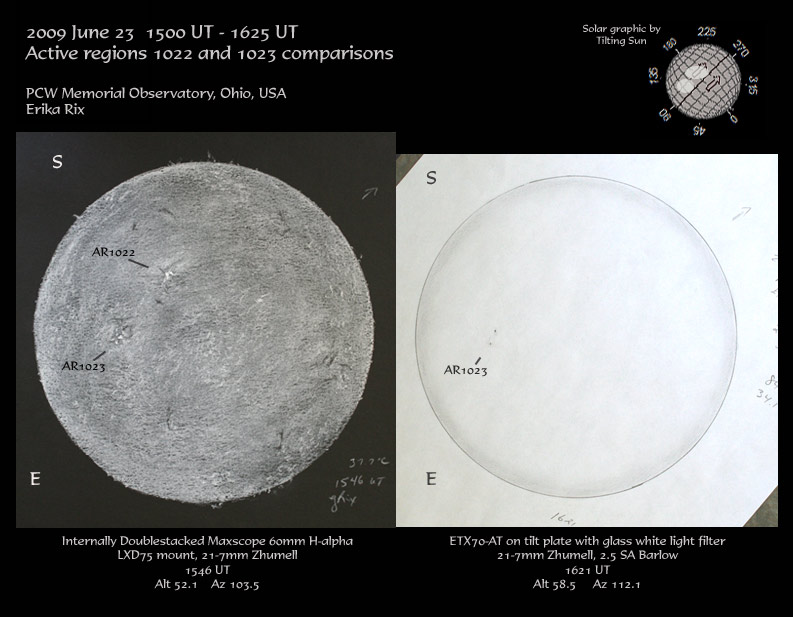Object name: Sunspots 1161 & 1162
Object type: Sun, sunspot
Date: 2011.02.20,52 UT
Technique: Graphite pencil, white paper, GIMP2
Equipment: R65/800, x80, ND5
Observer: Krzysztof Kida
Place: Elblag, Poland
Category: white light
Beautiful Sunspots
A Partial Solar Eclipse
Hello sketchers,all o.k.?This morning i have see one great astro phenomenon of 2011:The partial eclipse of our star!
Me and my friend Gianni go to little town of Montesecco,5 Km from my home and at 500 m of altitude.
I have the horyzon free to east,beautyfull vision of sunset.
I have my refractor Kenko 80/1000 with astrosolar filter,my friend his digital camera.
I draw the first sketch before eclipse at 7,48 a.m.
The eclipse start at 7,54 a.m. ,the sun only just rise.Incredible was the sensation of cold wind and blue light at the moment of maximum.
I make my sketches only quarter of hour until 10,40 a.m. when the eclipse end.
Thisis the first rough sketches copy,i sent you nextly the fair copy of that.
At next sketches,ciao!
Giorgio Bonacorsi.
Site:Montesecco,(fraction of Pergola’s municypality)
Date:4 of January 2011 from 7,54 to 10,40 a.m.
Instrument:Refractor Kenko 80/1000 with astrosolar filter
Eyepiece:25 mm ortoscopic,6mm lantanium for particular of sunspot.
Seeing:Good,only light clouds at start and at the end
Temperature:Icely at star,cold at the end.
Technics:graphite pencill on withe paper fabriano 4.
AR11040: CaK and White Light
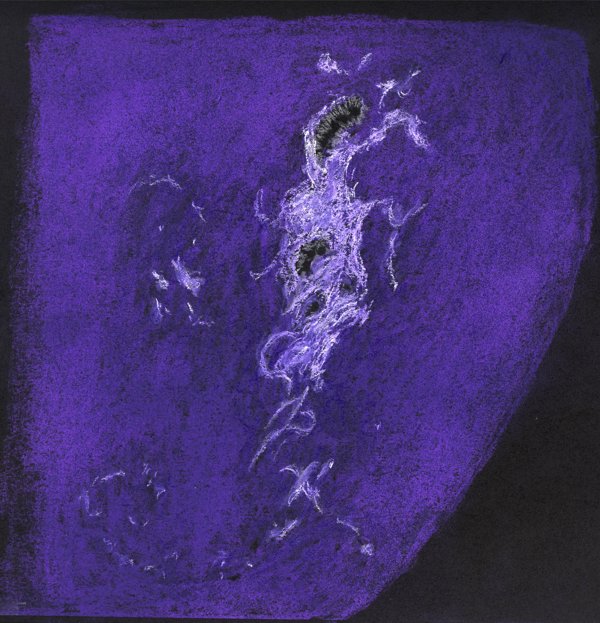
CaK AR11040 – January 14, 2010
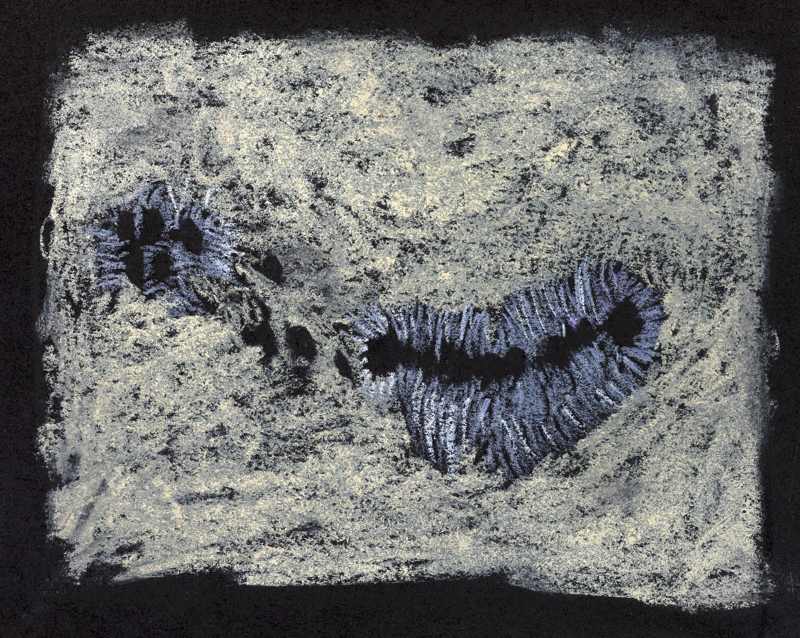
White Light AR11040 – January 14, 2010
Sketches and Details by Stephen W. Ramsden
Object Name AR11040
Object Type Solar Active Region and related Sunspots
Location Atlanta, GA –Jon Wood Observatory
Date 14 Jan 2010
The purple image is my interpretation of the Calcium K Line emissions from AR11040
The tan image is my sketch of the remaining Sunspot Group 1040 seen in white light
Conte chalks, pastels/Artagain paper, LUNT Solar Systems B1800 Cak Filter module on an Explore Scientific 127mm ED refractor.
I would strongly encourage all the solar photographers out there to give sketching a try. It gives you unique insights that cannot be caught on film. Thanks Stephen Ames and Erika for inspiration.
Stephen W. Ramsden
www.charliebates.org
January 14, 2010 Sun
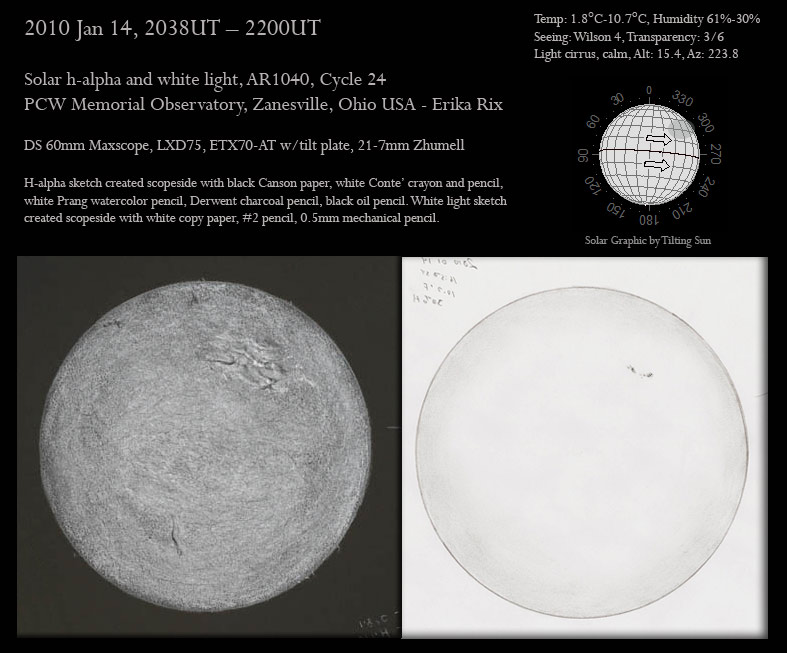
Sun – January 14, 2010, 2038 – 2200 UT
Sketch and Details by Erika Rix
2010 Jan 14, 2038UT – 2200UT
Solar h-alpha and white light, AR1040, Cycle 24
PCW Memorial Observatory, Zanesville, Ohio USA – Erika Rix
DS 60mm Maxscope, LXD75, ETX70-AT w/tilt plate, 21-7mm Zhumell
H-alpha sketch created scopeside with black Canson paper, white Conte’ crayon and pencil, white Prang watercolor pencil, Derwent charcoal pencil, black oil pencil. White light sketch created scopeside with white copy paper, #2 pencil, 0.5mm mechanical pencil.
Sketches were rotated and flipped to match standard solar orientation. West is to the right and north is to the top.
Temp: 1.8°C-10.7°C, Humidity 61%-30%
Seeing: Wilson 4, Transparency: 3/6
Light cirrus, calm, Alt: 15.4, Az: 223.8
The Sun and AR1035
Sun (AR1035)
Sketch and details by Michael Rosolina
Here are a pair of white light observations I made of a new Solar Cycle 24 active region which suddenly appeared on the solar disk on December 14th. One can see that these areas of solar activity are changing constantly as they rotate with the Sun. The sunspot group spans a distance from east to west of about nine Earth diameters or 72,000 miles/116,000 km.
The sketches were done in the field with 2B and HB graphite pencils. I viewed the Sun through handheld image stabilized binoculars with homemade filters over the objectives. Remember: NEVER look at the Sun unless you have approved solar filters covering the objective end of your telescope or binoculars or you are using a solar telescope designed for that purpose.
The Sun and AR 1035
Star and active region
White Sulphur Springs, WV USA
16 and 17 December 2009
Michael Rosolina
Sunspots on the Edge
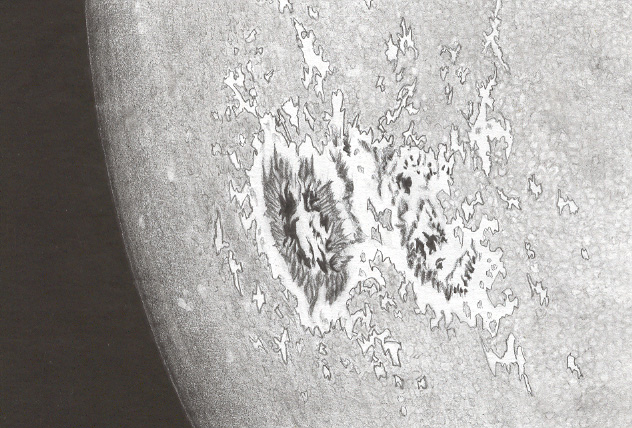
Active Region 1027 on October 29th, 2009
Sketch and Details by Fred Burgeot
* object : solar spot 1027.
* location : Vendée, France.
* date : 29/10/2009 at 14H15 TU.
Sketch made with graphite pencils (2H to 4B) on white paper. The telescope used is a 16″ Newtonian, equiped with Baader Astrosolar filter, magnification 175X with binoviewer.
It was made during afternoon, when the seeing conditions are currently better than in the morning.
Because of the proximity of the edge, a bright zone appears surrounding the spot group itself.
Best regards,
Fred Burgeot.
Three Days of AR 1024
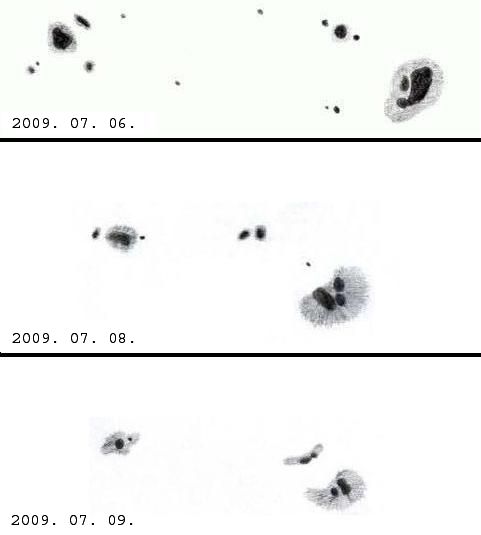
Active Region 1024 over a three day period
Sketch and Details by Balázs Benei
Name: Group 1024
Type: Sunspot
Location: Gyöngyös, Hungary
Date: 6-9th July 2009.
Hello,
These are my first sketches of our star. Everybody is very happy that the Sun is waking up and shows us these spots. It was very interesting to observe the changes of the group, now they are invisible for us.
My equipment: 110/800 (4′) Newtonian reflector, 2x barlow, 10mm eyepiece, 160x magnification.
Yours sincerely
Balázs Benei
The Sun is Waking Up
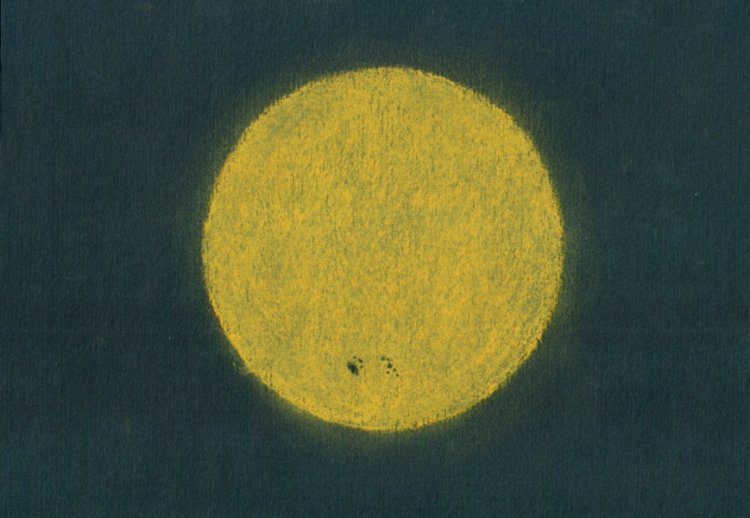
The white light Sun on July 6th, 2009
Sketch and Details by Aleksander Cieśla
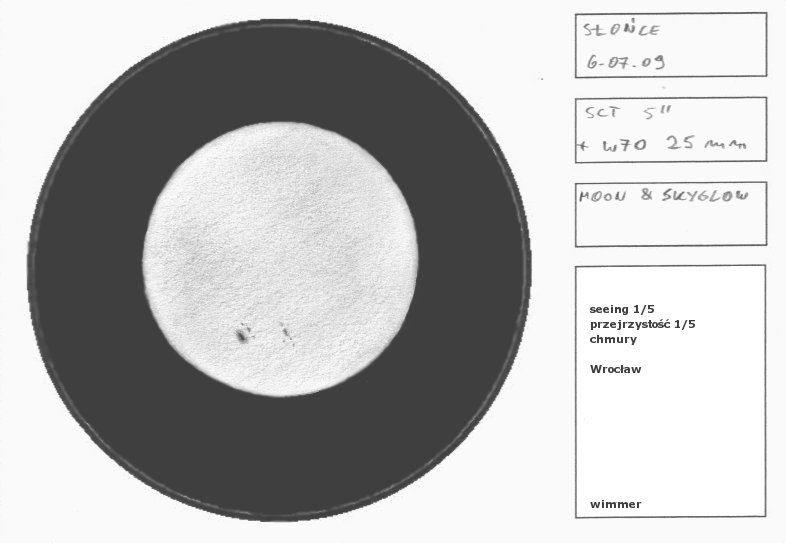
The Sun through a Baader Filter on July 6th, 2009
Sketch and Details by Aleksander Cieśla
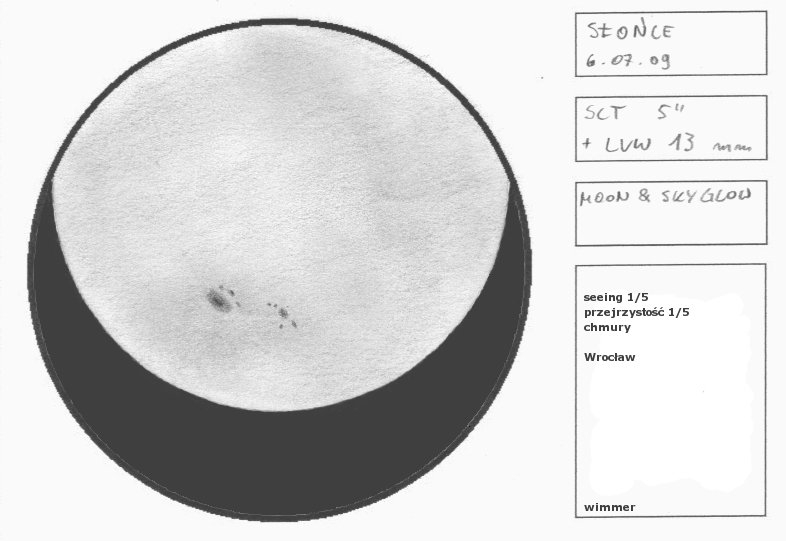
The Sun on July 6th, 2009
Sketch and Details by Aleksander Cieśla
Hi!
I think the Sun is waking up 🙂 This is sketch of the last Sun-spots.
Object: Sun and sunspots
Scope: Schmidt-Cassegrain 5″ with Antares W70 25mm and LVW 13mm
Filters: Sun filter Baader ND 5 and Baader Moon & Skyglow
Place: Poland, Wrocław – near city center
Weather: Bad. Seeing: 1/5. Transparency: 1/5. Light clouds.
Date: 6th July 2009
Technigue: Graphite pencil
Tooling: GIMP 2
Full Sun In a Grassy Field
Solar h-alpha, AR1023 and 1022: 2009 June 23
Sketch and Details by Erika Rix
2009 June 23, 1500UT – 1625UT
Solar h-alpha and White light, ARs 1023 & 1022
Erika Rix
PCW Memorial Observatory, Zanesville, Ohio USA
H-alpha 1546 UT, DS 60mm Maxscope, LXD75, 21-7mm Zhumell
Temp: 27.7°C
Seeing: Wilson 4.5, Transparency: 5/6
Clear with light cirrus, light breeze N
Alt 52.1 Az 103.5
Sketch created scopeside with black Strathmore Artagain paper, white
Conte’ crayon and pencil, white Prang watercolor pencil, black oil pencil.
Solar white light, AR1023 and 1022: 2009 June 23, 1621UT
Sketch and Details by Erika Rix
White light 1621 UT, ETX70-AT with tilt plate, 21-7mm Zhumell and 2.5x
SA Barlow
Temp: 30.2°C , Humidity 84%
Seeing: Wilson 2.8, Transparency: 5/6
Clear with light cirrus, winds NE 9mph
Alt 58.5 Az 112.1
Sketch created scopeside with white photocopy paper and #2 pencil.
Solar H-alpha and white light comparison: 2009 June 23, 1500UT-1625UT
Sketch and Details by Erika Rix
This morning, I moved the solar rigs outside for better seeing
conditions. After all the rains and then full sun today, the coolness
of the grassy fields would be a significant improvement over the hot
wood and carpet from inside the observatory. It appears my decision was
the correct one because I started the solar session off with h-alpha and
was able to not only increase mags to a 7mm, but used a 2.5x Barlow
toward the end of the
h-alpha session for deeper observing. The seeing became much worse
about an hour later when I began my white light filter observation.
Both active regions were obvious and 1023 almost looked like an “X”
shaped plage with a hint of a spot to the western crook of it. There was
another plage on the other side of that spot with a very prominent
filament reaching to the west, although very small with a more obvious
spot at the eastern start of it. Moving west across the disk, AR1022
was almost a “U” shaped plage resembling a pair of oxen horns with the
way each side of it curved outward.
There were many prominences, all fairly small, but they popped in and
out as I moved the Sun in my FOV for optimum clarity of features.
Speaking of the tilting of the Maxscope’s Etalons, I observed with Alan
Traino at a star party this weekend and had the chance to use a pressure
tuner on their 60mm Lunt h-alpha scope. What a great design! And I was
very impressed with the flat FOV, making it so much easier to pull out
details. Thanks Alan for supplying the scopes for us to try out. Wish
I had had more time to play with the pressure tuning scope as well as
the CaK.
The solar disk was speckled with network details and there were several
filaments, although again, very slender or very small.
The view with the white light filter was a little harder to discern
because of the dramatic change in seeing. Although I got a good focus,
I only had slight moments of seeing to make out a little bit of detail
within AR1023. What first looked like two oblong sunspots in that active
region became two pairs of sunspots. The preceding pair was the larger
with the following pair the smaller. There may have even been a third
little spot in the preceding pair but seeing prevented me from really
honing in on those two sets. There were no faculae that I could make
out, although there was a hint of contrast around both sets of spots as
well a faint line reaching from the preceding to the following pairs.


